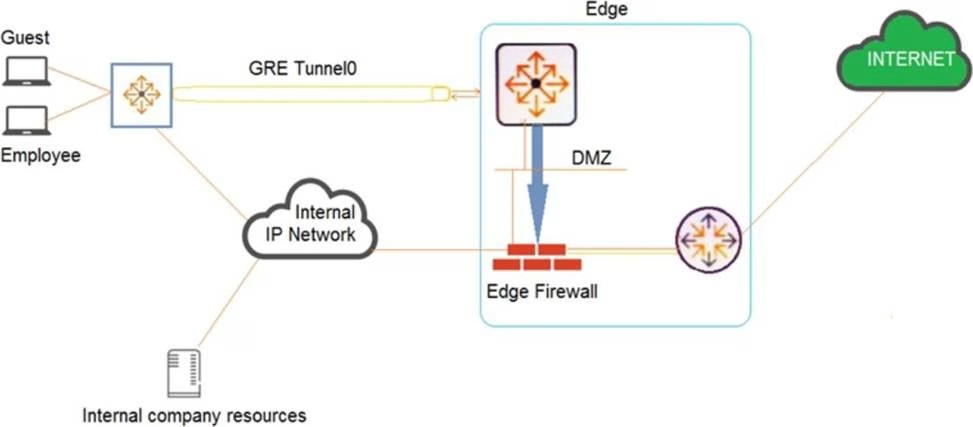HP HPE6-A73 Aruba Certified Switching Professional Exam Online Training
HP HPE6-A73 Online Training
The questions for HPE6-A73 were last updated at Dec 16,2025.
- Exam Code: HPE6-A73
- Exam Name: Aruba Certified Switching Professional Exam
- Certification Provider: HP
- Latest update: Dec 16,2025
How is voice traffic prioritized correctly on AOS-CX switches?
- A . By defining device profiles with QOS settings
- B . By placing it in the strict priority queue
- C . By implementing voice VLANs
- D . By implementing weighted fair queueing (WFQ)
An administrator is replacing the current access switches with AOS-CX switches. The access layer switches must authenticate user and networking devices connecting to them. Some devices support no form of authentication, and some support 802.1X. Some ports have a VoIP phone and a PC connected to the same port, where the PC is connected to the data port of the phone and the phone’s LAN port is connected to the switch.
Which statement is correct about this situation?
- A . 802.1X must be configured to work in fallback mode
- B . Device fingerprinting is required for authentication
- C . The client-limit setting for port access needs to be changed
- D . Device mode should be implemented
Examine the network exhibit.

A company has a guest implementation for wireless and wired access. Wireless access is implemented through a third-party vendor. The company is concerned about wired guest traffic traversing the same network as the employee traffic. The network administrator has established a GRE tunnel between AOS-CX switches where guests are connected to a routing switch in the DMZ.
Which feature should the administrator implement to ensure that the guest traffic is tunneled to the DMZ while the employee traffic is forwarded using OSPF?
- A . OSPF route maps using the “set metric” command
- B . Policy-based routing (PBR)
- C . User-based tunneling (UBT)
- D . Classifier policies
An administrator has an AOS-CX switch configured with:
router ospf 1
area 0
area 1 stub no-summary
It is the only ABR for area 1.
The switch has the appropriate adjacencies to routing switches in areas 0 and 1.
The current routes in each area are:
Area 0: 5 routes (LSA Type 1 and 2)
Area 1: 10 routes (LSA Type 1 and 2)
External routes: 2 (LSA Type 5)
Based on the above configuration, how many OSPF routes will routing switches see in Area 1?
- A . 15
- B . 6
- C . 11
- D . 12
A network administrator is managing a network that deploys a multicast service. The administrator has
multiple streams successfully being routed by PIM-DM in the network. The administrator then adds a new stream with a destination address of 239.0.0.1. However, clients who have not joined the stream are receiving it.
What should the administrator do to fix this problem?
- A . Verify that IGMP is enabled between the switches connecting the multicast source and receivers
- B . Change the destination multicast address to 239.1.1.1
- C . Define the 239.0.0.1 stream on the rendezvous point (RP)
- D . Define the 239.0.0.1 stream on the PIM candidate bootstrap router
Which protocols are used by NetEdit to interact with third-party devices? (Choose two.)
- A . telnet
- B . SNMP
- C . SSH
- D . Restful API
- E . CDP
An administrator is implementing a downloadable user role solution involving AOS-CX switches. The AAA solution and the AOS-CX switches can successfully authenticate users; however, the role information fails to download to the switches.
What policy should be added to an intermediate firewall to allow the downloadable role function to succeed?
- A . Allow TCP 443
- B . Allow UDP 1811
- C . Allow UDP 8211
- D . Allow TCP 22
A network administrator is attempting to troubleshoot a connectivity issue between a group of users and a particular server. The administrator needs to examine the packets over a period of time from their desktop; however, the administrator is not directly connected to the AOS-CX switch involved with the traffic flow.
What is correct regarding the ERSPAN session that needs to be established on an AOS-CX switch? (Choose two.)
- A . On the source AOS-CX switch, the destination specified is the switch to which the administrator’s desktop is connected
- B . On the source AOS-CX switch, the destination specified is the administrator’s desktop
- C . The encapsulation protocol used is GRE
- D . The encapsulation protocol used is VXLAN
- E . The encapsulation protocol is UDP
What is correct regarding the operation of VSX and multicasting with PIM-SM routing configured?
- A . Each VSX peers runs PIM and builds its own group database. One of the VSX peers is elected as the designated router (DR) to forward multicast streams to a receiver VLAN
- B . Each VSX peers runs PIM and creates a shared group database. Both VSX peers can forward multicast
streams to receivers in a VLAN, achieving load sharing - C . Each VSX peers runs PIM and builds its own group database. Both VSX peers can forward multicast streams to receivers in a VLAN, achieving load sharing
- D . Each VSX peers runs PIM and creates a shared group database. One of the VSX peers is elected as the designated router (DR) to forward multicast streams to a receiver VLAN
An administrator wants to track what configuration changes were made on a switch.
What should the administrator implement to see the configuration changes on an AOS-CX switch?
- A . AAA authorization
- B . Network Analysis Engine (NAE)
- C . AAA authentication
- D . VSX synchronization logging
Latest HPE6-A73 Dumps Valid Version with 100 Q&As
Latest And Valid Q&A | Instant Download | Once Fail, Full Refund

